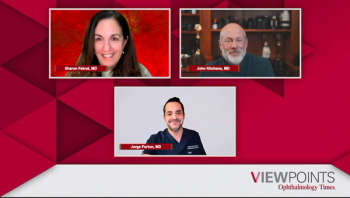
- Ophthalmology Times: September 1, 2020
- Volume 45
- Issue 14
Stem cells for dry AMD with GA show promise in early study
Patients underwent short-course, perioperative systemic immunosuppression prior to procedure
This article was reviewed by Christopher D. Riemann, MD
Subretinal transplantation of human embryonic stem cells-derived retinal pigment epithelial (RPE) cells in patients with
During the Association for Research in Vision and Ophthalmology virtual annual meeting, he presented interim results of a phase I/IIa trial investigating OpRegen for the treatment of dry AMD with GA (NCT02286089).
Related:
OpRegen is administered as a cell suspension, initially in a balanced salt solution but now in a thaw-and-inject formulation using CryoStor 5.
The US Food and Drug Administration has already granted OpRegen fast track designation, Riemann said.
RPE cell replacement is important because loss of RPE cells impairs drusen clearance, leading to the development of macular degeneration and corresponding central vision loss.
The trial’s primary objective was to assess the safety and tolerability of subretinally transplanted stem cell–derived RPE cells in patients with dry AMD and GA. The secondary objective looked at the cells’ survival and possible effects of OpRegen treatment by assessing changes in retinal structure and function.
Related:
Study design and procedure
The trial has 4 cohorts with advanced dry AMD and GA. Cohorts 1, 2, and 3 include 12 legally blind patients (visual acuity, < 20/200); cohort 4, which will include patients with better visual acuity and smaller atrophy (average visual acuity, 20/125), is still recruiting, with 5 of 12 patients enrolled. (See Table 1 for full cohort data).
Patients underwent short-course, perioperative systemic immunosuppression prior to the procedure.
The eyes with the poorest vision were implanted with 50,000 to 200,000 OpRegen cells subretinally in suspension either through a standard approach with pars plana vitrectomy and retinotomy or using the Gyroscope Therapeutics Orbit Subretinal Delivery System (SDS).
“The Orbit Subretinal Delivery System is a new surgical procedure using novel instrumentation,” Riemann said. “A sclerotomy is created, [and] a special cannula is placed tangentially into the suprachoroidal space and advanced posteriorly toward the target area in the macula, adjacent to the geographic atrophy.”
Related:
When the target area is reached, “a screw drive advances a needle through the choroid into the subretinal space,” he said. Next, a leading balanced salt solution subretinal bleb is created.
“Once we confirm a subretinal bleb, we turn a valve and switch from balanced salt solution to cells and deliver the OpRegen into the subretinal space,” Riemann said. “The subretinal injection is accomplished without a vitrectomy or retinotomy.”
Efficacy results
Patients in cohorts 1, 2, and 3 had no marked, sustained reductions in visual acuity. The 5 patients in cohort 4, however, had improved vision up to the 1-year follow-up period, including 1 patient who experienced a 10-letter gain that was sustained for 15 months.
“Improvements in drusen retinal outer layers and retinal pigment epithelium within the area of OpRegen transplant were observed and have persisted in some patients,” Riemann said.
“Asymmetrical progression of geographic atrophy in the treated areas has been observed. The change in the total area is trending toward slower growth in treated versus fellow eyes. Better visual acuity and improved reading speed have been observed in some early cohort patients and all cohort 4 patients after OpRegen.”
Related:
Adverse events
There were no reports of acute or delayed inflammation or increases in interocular pressure, but all patients reported at least 1 adverse event (AE). For systemic AEs, asthenia and malaise were reported by 4 patients.
“Subretinal pigmentation was common and presented in 11 out of 17 patients,” Riemann said. “[Although] the significance of this remains unclear, we believe it may represent a potentially positive finding as evidence of long-term survival of the subretinally transplanted OpRegen cells.”
Of note, among patients who received vitrectomy and retinotomy, 1 had a retinal detachment (successfully repaired) and 13 of 15 patients developed or experienced an exacerbation of an existing epiretinal membrane; 1 resulted in a temporary reduction in vision and required a vitrectomy, after which vision was restored.
“[Although] visual acuity improved after the peeling, the need for the vitrectomy to remove the epiretinal membrane is important,” Riemann said. “Though the cause of these epiretinal membranes remains unclear, we felt as if a possible etiology may have been migration of the OpRegen cells through the retinotomy in the vitreous cavity post transplantation, and this was an important underlying reason for us to explore the Orbit Subretinal Delivery System for transplantation of the OpRegen cells without a vitrectomy or retinotomy.”
Related:
Neither of the 2 cohort 4 patients operated on with the Orbit SDS have developed epiretinal membrane, macular pucker, lamellar hole, retinoschisis, or retinal detachment.
However, patients in the Orbit SDS group developed small, asymptomatic subretinal hemorrhages that resolved on their own. The significance of that AE is unknown.
--
Christopher D Riemann, MD
p: 513/984-5133
This article is adapted from Rieman’s virtual presentation at ARVO 2020. He has no financial disclosures related to this content.
Articles in this issue
about 5 years ago
Improve patient comfort with intravitreal injectionsabout 5 years ago
Ophthalmology taking the treatment conversation onlineabout 5 years ago
Astigmatism management software proving to be accurate, preciseabout 5 years ago
Examining ocular allergy, quality of lifeabout 5 years ago
Improving surgical safety, efficiency, and outcomes for patientsabout 5 years ago
FAF shedding light on patterns related to disease chronicity in CSCabout 5 years ago
IOL offering treatment options for ophthalmologistsover 5 years ago
Unproductive worry: Conquering fear during a pandemicNewsletter
Don’t miss out—get Ophthalmology Times updates on the latest clinical advancements and expert interviews, straight to your inbox.












































.png)


